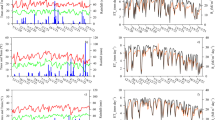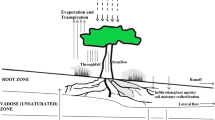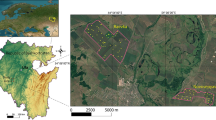Abstract
A 4-year experiment was conducted using a large weighing lysimeter to determine the crop coefficient and crop water use of a late-season peach cultivar (Prunus persica (L.) Batsch, cultivar O'Henry) irrigated with a surface drip system. Two trees were planted in a 2×4×2 m deep weighing lysimeter that was surface irrigated with ten 2 L/h in-line drip emitters spaced evenly around the trees. Irrigation was applied in 12 mm applications after a 12 mm water loss threshold was exceeded as measured by the lysimeter. The crop coefficient (K c) was calculated using the measured water losses and grass reference evapotranspiration calculated using the CIMIS Penman equation. K c was plotted against day of the year and linear, quadratic, and cubic regressions were fitted to the data. A three-segment linear and the cubic equation had the best fit to the data. The maximum K c determined for the linear fit in this experiment was 1.06 compared with a maximum of 0.92 recommended for use in California and 0.98 calculated using the FAO method. Average annual water use for the 4 years of the experiment was 1,034 mm. Mid-day canopy light interception was found to be well correlated with the crop coefficient determined using the lysimeter data.





Similar content being viewed by others
References
Allen RA, Pereira LS, Raes D, Smith M (1998) Crop evapotranspiration: guidelines for computing crop water requirements. (FAO irrigation and drainage paper 56) Food and Agriculture Organization of the United Nations, Rome
Annandale JG, Stockle CO (1994) Fluctuation of crop evapotranspiration coefficients with weather: a sensitivity analysis. Irrig Sci 15:1–7
Ben-Asher J, Matthias AD, Warrick AW (1983) Assessment of evaporation from bare soil by infrared thermometry. Soil Sci Soc Am J 47:185–191
Black TA, Tanner CB, Gardner WR (1970) Evaporation from a snap bean crop. Agron J 62:66–69
Chalmers DJ, Olsson KA, Jones TR (1983) Water relations of peach trees and orchards. In: Kozlowski TT (ed) Water deficits and plant growth, vol. VII. Academic Press, New York
Chalmers DJ, Andrews PK, Harris KM, Cameron EA (1992) Performance of drainage lysimeters for evaluation of water use by Asian pears. HortScience 27:263–265
DeJong TM, Doyle JF, Day KR (1987) Seasonal patterns of reproductive and vegetative sink activity in early and late maturing peach (Prunus persica) cultivars. Physiol Plant 71:83–88
DeJong TM, Day KR, Doyle JF, Johnson RS (1994) The Kearney Agricultural Center perpendicular V orchard system of peaches and nectarines. HortTechnology 4 (4):326–367
Fereres E, Goldhamer DR (1990) Deciduous fruit and nut trees. In: Stewart BA, Neilsen DR (eds) Irrigation of agricultural crops. (Agronomy monograph no. 30) American Society of Agronomy, Madison, Wis., pp 987–1017
Fereres E, Martinich DA, Aldrich TM, Castel JR, Holzapfel E, Schulbach H (1982) Drip irrigation saves money in young almond orchards. Calif Agric 36(9–10):12–13
Katul GG and Parlange MB (1992) Estimation of bare soil evaporation using skin temperature measurements. J Hydrol 132:91–106
Lascano RJ, Bavel CHM van, Hatfield JL, Upchurch DR (1987) Energy and water balance of a sparse crop: simulated and measured soil and crop evaporation. Soil Sci Soc Am J 51:1113–1121
Mitchell PD, Boland AM, Irvine JL, Jerie PH (1991) Growth and water use of young, closely planted peach trees. Sci Hortic 47:283–293
Miyamoto S (1983) Consumptive water use of irrigated pecans. J Am Soc Hortic Sci 108:676–681
Phene CJ, Hoffman GJ, Howell TA, Clark DA, Mead RM, Johnson RS, Williams LE (1991) Automated lysimeter for irrigation and drainage control. In: International symposium on lysimeters for evapotranspiration and environmental measurements,Honolulu, Hawaii. IR Div/ASCE, pp 28–36
Pruitt WO, Doorenbos J (1977) Empirical calibration, a requisite for evapotranspiration formulae based on daily or longer mean climatic data. In: International round table conference on "evapotranspiration", Budapest, Hungary. International Commission on Irrigation and Drainage, New Delhi, India
Reddy K (1983) A simple method of estimating the soil water balance. Agric Meteorol 28:1–17
Ritchie JT, Johnson BS (1990) Soil and plant factors affecting evaporation. In: Stewart BA, Nielsen DR (eds) Irrigation of agricultural crops. ASA, CSSA, SSSA, Madison, Wis.
Snyder RL, Lanini BJ, Shaw DA, Pruitt WO (1989) Using reference evapotranspiration (ETo) and crop coefficients to estimate crop evapotranspiration for trees and vines. (Leaflet 21428) Cooperative Extension, University of California, Division of Agriculture and Natural Resources
Tanner CB, Jury WA (1976) Estimating evaporation and transpiration from a row crop during incomplete cover. Agron J 68:239–243
Wallace JS, Jackson NA, Ong CK (1999) Modelling soil evaporation in an agroforestry system in Kenya. Agric For Meteorol 94:189–202
Worthington JW, McFarland MJ, Rodrigue P (1984) Water requirement of peach as recorded by weighing lysimeters. HortScience 19:90–91
Wright JL (1982) New evapotranspiration crop coefficients. Irrigation and Drainage Division, American Society of Civil Engineers 108 IR1:57–74
Acknowledgements
The authors wish to thank Dr. Rick Snyder for his analysis of the data and development of the linear model and Dr. Bruce Mackey for his statistical analysis of the data and the development of the cubic and quadratic expressions. Thanks also go to Dr. Rick Allen for his review and comments and the development of the FAO 56 model. Product names are given for the benefit of the reader and do not imply endorsement by USDA-ARS.
Author information
Authors and Affiliations
Corresponding author
Additional information
Communicated by P. Thorburn
Rights and permissions
About this article
Cite this article
Ayars, J.E., Johnson, R.S., Phene, C.J. et al. Water use by drip-irrigated late-season peaches. Irrig Sci 22, 187–194 (2003). https://doi.org/10.1007/s00271-003-0084-4
Received:
Accepted:
Published:
Issue Date:
DOI: https://doi.org/10.1007/s00271-003-0084-4




